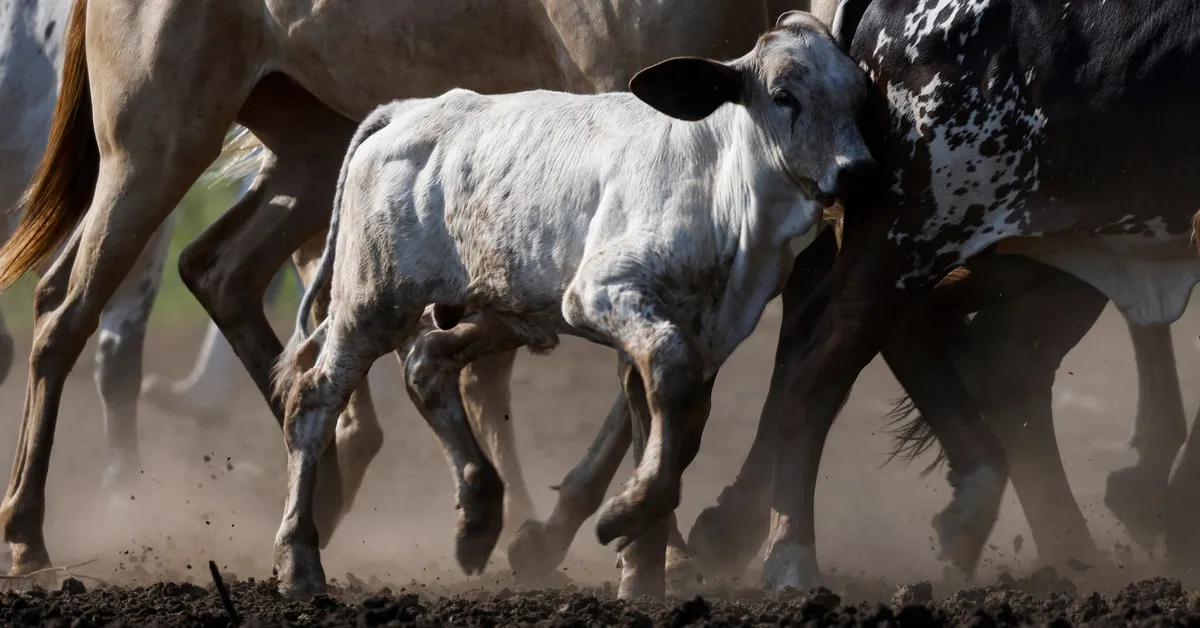
In Live Oak County, Texas, ranchers are grappling with the ominous return of the screwworm, a parasitic fly notorious for its gruesome effects on livestock. Veteran rancher Kip Dove, who was just eight years old during the last significant outbreak in 1973, vividly recalls the harrowing days spent caring for infected cattle. Armed with a bottle of repugnant, tar-like medicine and a revolver to euthanize beyond-saving animals, Dove navigated through the chaos of distressed cattle, dogs, and cowboys under the glaring truck headlights. Now, surrounded by a thriving herd of longhorns, he finds himself anxious about the potential resurgence of this deadly parasite.
The infamous screwworm outbreak that spanned from 1972 to 1976 devastated tens of thousands of cattle across six states in the U.S., leading to costs in the millions for containment efforts. This parasitic menace thrives by laying hundreds of eggs in open wounds of warm-blooded animals. Once hatched, the larvae burrow into living flesh, feeding on it and expanding the wounds, often leading to the host's death if untreated. Dove recalls the horrific sights from that era: "You have humongous holes in these animals teeming with worms," he stated, expressing the dread of witnessing such suffering again.
In response to the potential outbreak, the U.S. government has halted cattle imports from Mexico and invested millions into establishing a new sterile fly production facility in Metapa, Mexico. However, this facility won’t be operational for about a year, leaving U.S. cattle producers in a precarious situation. As they stockpile insecticides and devise contingency plans, they are simultaneously sounding alarms over the diminishing number of skilled ranch laborers capable of detecting and treating screwworm infestations. Treatment involves labor-intensive methods, requiring ranchers and veterinarians to manually remove each worm before applying insecticides.
Freddy Nieto, who manages El Sauz Ranch in South Texas, emphasizes the urgency of the situation, stating, "This might be the worst biological outbreak that we’re facing in our lifetime." With the multi-billion-dollar hunting industry particularly vulnerable, wildlife infested with screwworms often succumb to their wounds in the dense brush, making it nearly impossible to treat them. The implications of a screwworm resurgence extend beyond cattle ranching; they threaten the livelihood of ranchers and hunters alike.
Since 2006, a biological facility in Panama City has been working tirelessly to combat screwworms. Here, biologists breed up to 100 million sterile screwworm flies each week, feeding them a specially formulated diet to replicate conditions that attract wild females. These sterile flies are then released into key areas to mate with wild females, producing infertile eggs and helping to control the population. Until recently, these sterile flies were deployed in the Darien Gap to prevent the northward spread of screwworms, but the focus has now shifted to Mexico.
The challenge of controlling the screwworm outbreak is compounded by logistics. The USDA estimates that approximately 500 million sterile flies need to be released weekly to push the infestation back to the Darien Gap, yet the Panama facility can only produce 100 million at its peak. Dr. Lansford, a leading expert on the matter, describes the situation as "overwhelming," noting that the screwworm population is thriving in Mexico amidst similar challenges faced by U.S. ranchers.
In Tapachula, Mexico, livestock veterinarian Alfonso Lopez reports new cases of screwworms daily, showcasing the urgent need for intervention. The Chiapas state, identified as the epicenter of the outbreak, has seen a 10% weekly increase in cases, totaling nearly 50,000 reported instances from Panama to Mexico. Ranchers like Julio Herrera remain vigilant, regularly inspecting their herds for signs of screwworm, but they stress the necessity for governmental action to address illegal livestock crossings, which contribute to the outbreak.
Despite government efforts, many U.S. ranches lack the skilled labor essential for monitoring and treating herds. Ranchers need experienced cowboys who can assess cattle health at a glance and manage the strenuous tasks associated with an outbreak. Isaac Sulemana, a rancher from Sullivan City, Texas, highlights the alarming labor shortage, stating he requires at least ten cowboys but currently has only two.
The path to preventing livestock deaths during a screwworm outbreak demands a rigorous daily monitoring routine, yet ranchers like Dove find this increasingly challenging. As he navigates the rugged terrain of Texas cattle country, the difficulty of locating and caring for scattered cattle becomes starkly evident. In anticipation of potential outbreaks, ranchers are preparing by stocking up on necessary supplies, echoing sentiments of repeating history after 50 years of hard-fought eradication.
Warren Cude, a third-generation rancher, expresses his frustration: "We didn’t learn from the first time and we let those facilities go, and now we’re having to do everything again to combat something we eradicated 50 years ago." As ranchers brace for the worst, the specter of the screwworm looms large, threatening the future of cattle ranching across the U.S. and Mexico.